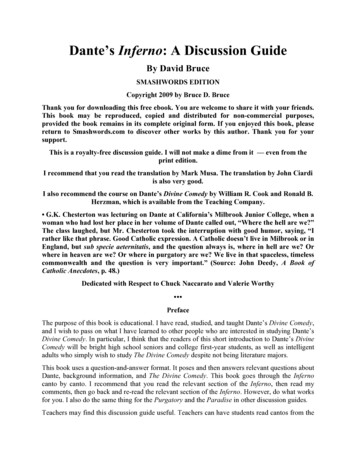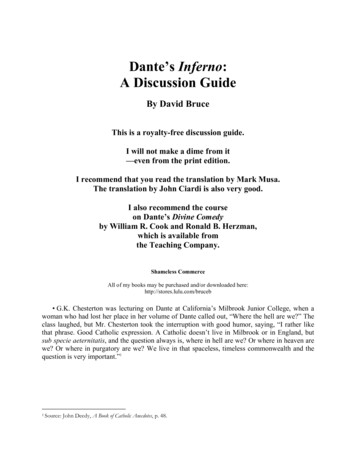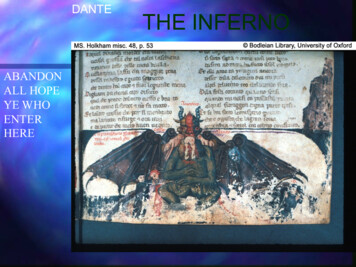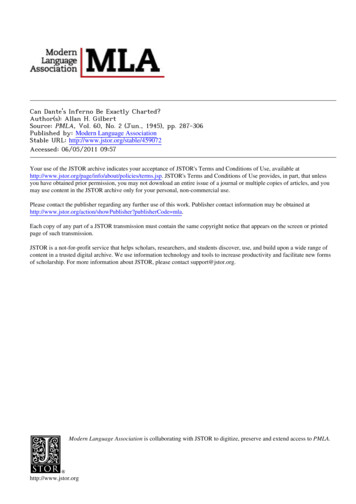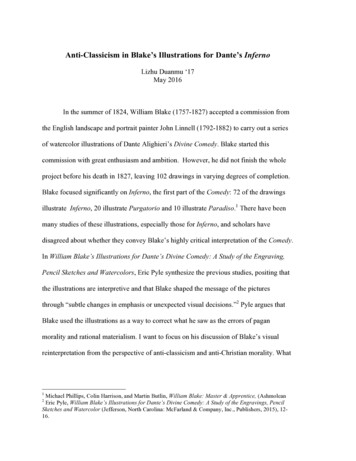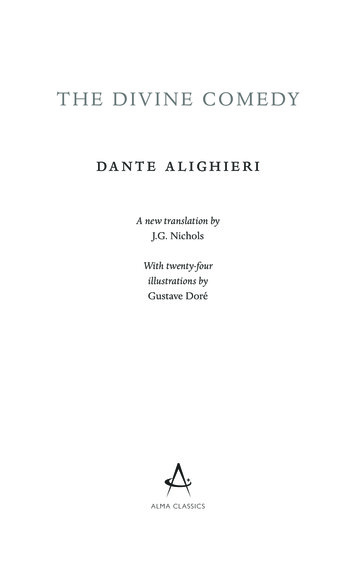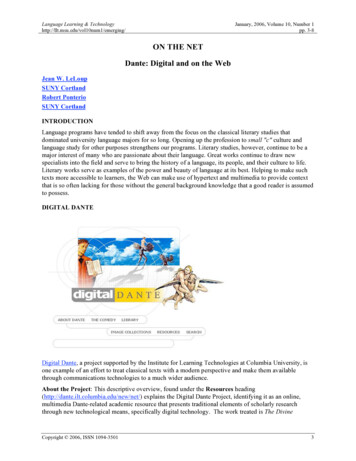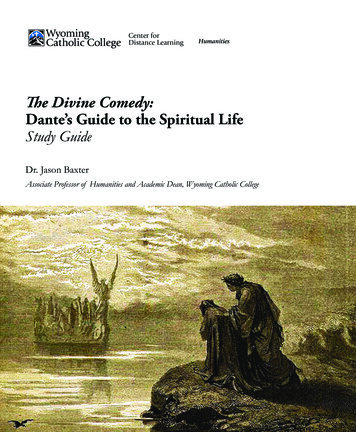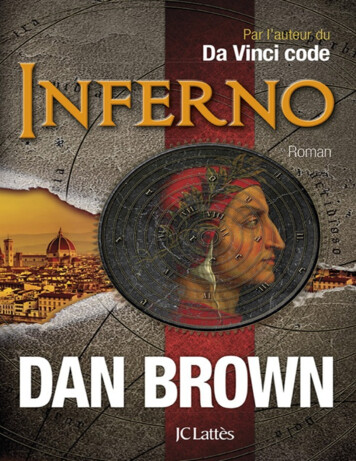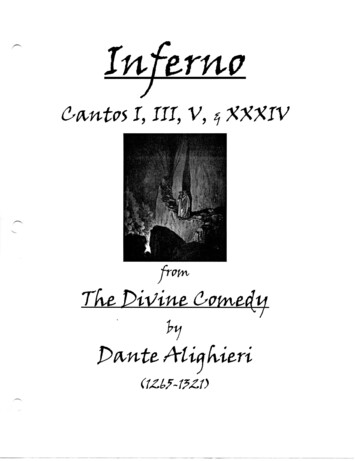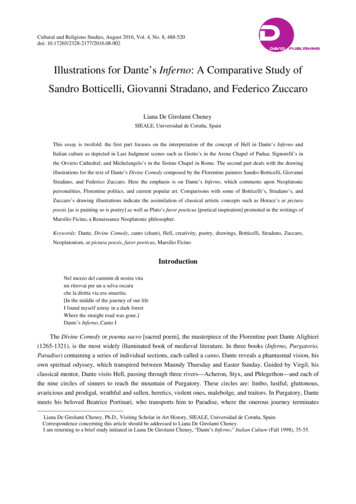
Transcription
Cultural and Religious Studies, August 2016, Vol. 4, No. 8, 488-520doi: strations for Dante’s Inferno: A Comparative Study ofSandro Botticelli, Giovanni Stradano, and Federico ZuccaroLiana De Girolami Cheney SIEALE, Universidad de Coruña, SpainThis essay is twofold: the first part focuses on the interpretation of the concept of Hell in Dante’s Inferno andItalian culture as depicted in Last Judgment scenes such as Giotto’s in the Arena Chapel of Padua; Signorelli’s inthe Orvieto Cathedral; and Michelangelo’s in the Sistine Chapel in Rome. The second part deals with the drawingillustrations for the text of Dante’s Divine Comedy composed by the Florentine painters Sandro Botticelli, GiovanniStradano, and Federico Zuccaro. Here the emphasis is on Dante’s Inferno, which comments upon Neoplatonicpersonalities, Florentine politics, and current popular art. Comparisons with some of Botticelli’s, Stradano’s, andZuccaro’s drawing illustrations indicate the assimilation of classical artistic concepts such as Horace’s ut picturapoesis [as is painting so is poetry] as well as Plato’s furor poeticus [poetical inspiration] promoted in the writings ofMarsilio Ficino, a Renaissance Neoplatonic philosopher.Keywords: Dante, Divine Comedy, canto (chant), Hell, creativity, poetry, drawings, Botticelli, Stradano, Zuccaro,Neoplatonism, ut pictura poesis, furor poeticus, Marsilio FicinoIntroductionNel mezzo del cammin di nostra vitami ritrovai per un a selva oscurache la diritta via era smarrita.[In the middle of the journey of our lifeI found myself astray in a dark forestWhere the straight road was gone.]Dante’s Inferno, Canto IThe Divine Comedy or poema sacro [sacred poem], the masterpiece of the Florentine poet Dante Alighieri(1265-1321), is the most widely illuminated book of medieval literature. In three books (Inferno, Purgatorio,Paradiso) containing a series of individual sections, each called a canto, Dante reveals a phantasmal vision, hisown spiritual odyssey, which transpired between Maundy Thursday and Easter Sunday. Guided by Virgil, hisclassical mentor, Dante visits Hell, passing through three rivers—Acheron, Styx, and Phlegethon—and each ofthe nine circles of sinners to reach the mountain of Purgatory. These circles are: limbo, lustful, gluttonous,avaricious and prodigal, wrathful and sullen, heretics, violent ones, malebolge, and traitors. In Purgatory, Dantemeets his beloved Beatrice Portinari, who transports him to Paradise, where the onerous journey terminates Liana De Girolami Cheney, Ph.D., Visiting Scholar in Art History, SIEALE, Universidad de Coruña, Spain.Correspondence concerning this article should be addressed to Liana De Girolami Cheney.I am returning to a brief study initiated in Liana De Girolami Cheney, “Dante’s Inferno,” Italian Culture (Fall 1998), 35-55.
ILLUSTRATIONS FOR DANTE’S INFERNO489with redemption and salvation.1 The poema sacro is an exploration into human nature—weakness, limitation,and potential—a religious and spiritual allegory of perdition, transformation, and salvation; and a philosophicaljourney of the Christian soul seeking to understand God’s creation.Exiled from Florence for life in 1302, Dante began writing this poema sacro sometime around 1308 andcompleted it in 1321. At the age of 35 (“in the middle of the journey of our life”), he was concerned withhistory, Florentine politics, the corruption of the clergy, the moral position of his contemporaries, and most ofall the state of his own spirit or soul.2 Dante expressed his emotions by creating with words sensations of sights,sounds, and smells, thus visualizing for the reader the effects of good and evil in the world.3Weaving Christian theology with excessive, sometimes scatological, images of illicit pleasures and grislypunishment involving historical, mythical, and contemporary figures, the Inferno understandably quicklyattracted both commentary and illustrations.4 Renaissance artists from the fourteenth century to the sixteenthbecame fascinated with its poetic visualization and then illustrated its images both in drawings and paintings.The first commentary on Dante’s Divine Comedy was done by his son Jacopo. Entitled Ottimo, thiscommentary was written in Florence around 1340 and illuminated by Bartolomeo di Fruosino in 1420. Themanuscript can be found in the Bibliothèque nationale in Paris (MS ital. 74) and the drawings in the BibliotecaLaurenziana in Florence (MS Plut. 40, 16, fol., 1v). The manuscript contains an author portrait, now on folio 3r,and also a full-page illumination of Dante and Virgil surveying the topography of Hell, now on folio 1v(bifolium 2 was added sometime around 1449).5In the Quattrocento (fifteenth century), the Platonic Academy of Florence restored Dante’s reputation withits publication of Cristoforo Landino’s Commentary on the Divine Comedy on August 30, 1481. SandroBotticelli (1445-1510) was commissioned to design 19 drawings to accompany the text of Landino’s edition.61Dante Alighieri, La Divina Commedia, ed. and trans. C. H. Grandgent and revised by Charles S. Singleton (Cambridge, MA:Harvard University Press, 1972); Dante’s Divine Comedy, ed. and trans. in literary prose by Charles S. Singleton (Princeton:Princeton University Press, 1970-1991); Dante’s Divine Comedy, ed., trans. Mark Musa, Vol. 3 (Baltimore: Penguin Classics,1967-2002); The Divine Comedy, ed. and trans. Allen Mandelbaum (New York: Vintage, 1980, 1995, 2013). See Robert Pinsky,The Inferno of Dante (New York: Farrar, Straus & Giroux, 1994-1906, bilingual edition), for a dramatic translation of Dante’sInferno and monotypes of Michael Mazur; and Allen Mandelbaum, Anthony Oldcorn, and Charles Ross, Inferno: ACanto-by-Canto Commentary (Berkeley: University of California Press, 1998), for a clear study in English of Dante’s Inferno; Ihave used this as the source reference for interpretation of the cantos.2See Mandelbaum, et al., Inferno: A Canto-by-Canto Commentary, 1-8, for a discussion on Dante and his time.3For general references to Dante, see John Arthos, Dante, Michelangelo and Milton (London: Routledge & Kegan Paul, 1963);Thomas G. Bergin, Dante (New York: The Orion Press, 1964); Charles T. Davis, Dante’s Italy and Other Essays (Philadelphia:University of Pennsylvania Press, 1984); Robin Kirkpatrick, Dante: The Divine Comedy (New York: Cambridge University Press,1987); Rachel Jacopff, ed., The Cambridge Companion to Dante (New York: Cambridge University Press, 1993); Ricardo J.Quinones, Foundation Sacrifice in Dante’s Commedia (University Park: The Pennsylvania State University Press, 1994); HelenM. Luke, Dark Wood to White Rose: Journey and Transformation in Dante’s Divine Comedy (New York: Parabola Books, 1989);and Charles H. Taylor and Patricia Finely, Images of the Journey in Dante’s Divine Comedy (London: Yale University Press,1997). See Wallace Fowlie, Dante’s Inferno (Chicago: University of Chicago Press, 1981), 3-17, for a succinct and clear historicalaccount of Dante’s compositions for the Divine Comedy.4G. Biagi, La Divina Commedia nella figurazione artistica e nel secolare comment [The Divine Comedy in VisualRepresentations and Commentary], Vol. 3 (Turin: UTET, 1924); P. Brieger, M. Meiss, and C. S. Singleton, IlluminatedManuscripts of the Divine Comedy, Vol. 2 (Princeton: Princeton University Press, 1969); Eugene Paul Nassar, Illustrations toDante’s Inferno (London: Associated University Press, 1994).5Laurence B. Kanter, Painting and Illumination in Early Renaissance Florence, 1300-1450 (New York: Metropolitan Museumof Art, 1994).6Adolfo Venturi, Il Botticelli: Interprete di Dante [Botticelli: Intepreter of Dante] (Florence: Felice Le Monnier, 1921), 7-13;Kenneth Clark, The Drawings by Sandro Botticelli For Dante’s Divine Comedy: After the Originals in the Berlin Museum andVatican (New York: Harper & Row, Publishers, 1976), 7-24; Corrado Gizzi, Botticelli e Dante (Milan: Electa, 1990), 100-03;Peter Dreyer, “Botticelli’s Series of Engravings of 1481,” Print Quarterly (June 1984), 111-115; Ronald Lightbown, Botticelli,
490ILLUSTRATIONS FOR DANTE’S INFERNOBotticelli’s drawings were in turn incised in woodcuts by Baccio Baldini (1436-1487) and printed with theDante text by Niccolò di Lorenzo della Magna in Florence. One year later, in 1482, Lorenzo Pierfrancesco de’Medici (1463-1503) requested a second edition. Due to other artistic engagements, Botticelli delayed executingthis commission until 1490.In subsequent years, editions of Landino’s commentary were published in Venice, two of which wereissued in 1536 and 1544 with the observations of Alessandro Vellutello. In 1551, a Lyon edition by GuglielmoRovillo reported and commented on Vellutello’s observations, with subsequent reprints of this edition beingpublished in 1552 and 1575. In 1554, Giovanni Antonio Morandi printed Rovillo’s edition in Venice. In 1564,with other reprints to follow in 1578 and 1596, Francesco Sansovino edited another version of Dante’s poemasacro, adding his own notations and incorporating the previous commentaries of Cristoforo Landino andAlessandro Vellutello.7The first part of this essay focuses on the interpretation of the concept of Hell in Dante’s Inferno andItalian culture as depicted in Last Judgment scenes such as Giotto’s Last Judgment of 1305 in the Arena Chapelin Padua; Signorelli’s frescoes of 1503 in the Orvieto Cathedral; and Michelangelo’s Last Judgment of 1541 inthe Sistine Chapel in Rome. The second part deals with the drawing illustrations for the text of Dante’s DivineComedy composed by the Florentine painters Botticelli, Giovanni Stradano (1523-1605), and Federico Zuccaro(c. 1540-1609). The emphasis is on Dante’s Inferno, which comments on Neoplatonic personalities, Florentinepolitics, and current popular art.8 Comparisons with some of Botticelli’s, Stradano’s, and Zuccaro’s drawingillustrations indicate the assimilation of classical artistic concepts such as Horace’s ut pictora poesis [as ispainting so is poetry] as well as Plato’s furor poeticus [poetical inspiration] promoted in the writings ofMarsilio Ficino, a Renaissance Neoplatonic philosopher.Concept of Hell in the Renaissance: Visio TundaliIt may be asked why the Platonic Academy of Florence decided in the 15th century to revive Dante’sLife and Work, Vol. 2 (Berkeley: University of California Press, 1978); Barbara Watts, Studies in Sandro Botticelli’s Drawingsfor Dante’s Inferno (Ph.D. diss., University of Virginia, 1989); Barbara J. Watts, “Sandro Botticelli’s Drawings for Dante’sInferno: Structure, Topography, and Manuscript Design,” Artibus et Historiae 16.32 (1995), 163-201; Barbara J. Watts, “SandroBotticelli’s Illustrations for Inferno VIII and IX: Narrative Revision and the Role of Manuscript Tradition,” Word and Image AJournal of Verbal/Visual Enquiry 2 (April-June, 1995), 149-173; Barbara J. Watts, “Artistic Competition, Hubris, and Humility:Sandro Botticelli’s Response to Visibile parlare,” in Dante Studies 114 (1996), 41-79; Barbara Watts, “Pictorial Wit and Parodyas Narrative Tools: Botticelli’s Drawings for Dante’s Inferno,” oral presentation at the Boston Dante Society, 1998); Barbara J.Watts, “The Word Imaged: Dante’s Commedia and Sandro Botticelli’s San Barnaba Altarpiece,” in Lectura Dantis 22-23 (1998),203-245; and Hein-Thomas Schulze Altcappenberg, Sandro Botticelli: The Drawings for Dante’s Divine Comedy, Vol. 2(London/Rome: Royal Academy of The Arts and Scuderie Papali al Quirinale, 2000), an excellent exhibition of these drawings.7Corrado Gizzi, ed., Federico Zuccari e Dante (Milan: Electa, 1993), 71-73.8Corrado Ricci, La Divina Commedia di Dante Alighieri nell’arte del Cinquecento [The Divine Comedy of Dante Alighieri in the Artof Sixteenth Century]. Milan: Treves, 1908); Corrado Gizzi, ed., Botticelli e Dante (Milan: Electa, 1993); Corrado Gizzi, ed.,Signorelli e Dante (Milan: Electa 1991); Gizzi, Federico Zuccari e Dante; Corrado Gizzi, ed., Giovanni Stradano e Dante (Milan:Electa, 1994); Charles H. Taylor and Patricia Finley, Images of the Journey of Dante’s Divine Comedy (London: Yale UniversityPress, 1997). Even today artists such as Michael Mazur are moved by the poema sacro. Mazur’s monotypes illustrate Robert Pinsky’sThe Inferno of Dante. Mazur’s imagery combines his personal interpretation of the poema sacro and his visual impressions ofFlorence. The effects of tenebrism in his monotypes create infernal images fusing the visual tradition of past Dante’s imagery withhis present apperception of visualizing a poem and experiencing Dante’s history. For example, the frontispiece illustrates CantoIII with the boat of Charon passing through the bridges of the Arno River. For Canto VIII, Mazur also draws from the topographyof Florence, including in mist the tower of Palazzo Vecchio and surrounding it with burning flames, an image inspired by Dante’sFuries at the City of Dis. Mazur’s Cantos IX (Virgil’s description of Hell) and XXXIV (Lucifer or Simia Dei) undoubtedly representtwo of the most fearful Dantesque images. Redemption, forgiveness, and hope are indeed abandoned.
ILLUSTRATIONS FOR DANTE’S INFERNO491Divine Comedy. Perhaps one reason was the Church’s desire to abolish witchcraft.9 In 1484, Pope InnocentVIII (1432-92) issued a bull condemning witchcraft in Europe, particularly in Germany, and he established acommittee to destroy this spread of maleficence. The committee was governed by two of the pope’s sons: theDominican friar and inquisitor Heinrich Institor (Kramer, 1430-1505), and Jakob Sprenger (1436-95). Twoyears after the papal bull, the inquisitors printed an encyclopedia of demonology, the Malleus Maleficarum[The Hammer of Witches].10These two events—the papal bull of 1484 and publication of the results of the investigations in1486—served as the sources for a new Western mythology. It established a systematic demonology based onthe fusion of social fears, popular superstitions, intellectual cosmology, and tales from folklore.11 The meansemployed by the Christian Church in its desire to eliminate heresy and witchcraft ironically contributed to theexpansion of witchcraft in Europe. Witchcraft or witchcraze was used by individuals for personal gain and wasemployed as a political tool to destroy enemies.Publication of the Malleus Maleficarum coincided with a general fascination with the Danse Macabre(Dance of Death) artistic genre. Engravings books were printed on the Visio Tundali (The Vision of Tundale;translation of a twelfth-century text telling of an otherworldly vision) and The Art of Dying (see Verard’s ArsMoriendi of 1484). The latter dealt with the relatively new obsession with dying and the paraphernaliaassociated with death and dissolution.12 As this mania for death persisted, the modern art of healing began toevolve and was the subject of popular books that included information from medical texts and treatisesconcerning the use of herbal remedies for sickness as well as astrology manuals offering advice for betterliving.13The Church used the popular eschatological Visio Tundali to combat the witchcraze of the fifteenth andsixteenth centuries. It desired to expose the evil of magic and debunk superstitions, divine spirits, idolatry,demonic doctrine, and false knowledge. Thereby the followers of witches would be intimidated and return tothe one true faith, viz., Christianity. The Malleus Maleficarum taught its readers about evil or Simia Dei: “Wemay say that the devil can posses [an individual] we may say that since [an individual] is by any mortal sinbrought into devil’s service the devil provides suggestion of sin either to the senses or to the imagination, tothat event the devil is said to inhabit in man ”14The new mythology that arose in Europe during the fifteenth and sixteenth centuries was based on thetraditional dualism of good and evil or God and the Devil but advanced new depictions of the devil. The9See Jules Michelet, Satanism and Witchcraft: A Study in Medieval Superstition (New York: The Citadel Press, 1970); HenryAnsgar Kelly, The Devil, Demonology and Witchcraft (New York: Doubleday & Company, 1968); Charles Moeller, ed., Satan(New York: Sheed & Ward, 1952); and Everett Ferguson, Demonology of the Early Christian World (London: The Edwin MellenPress, 1953).10Francesco Maria Guazzo, Malleus Maleficarum (New York: Dover Publications, The Montague Summers Edition, 1988).11Guazzo, Malleus Maleficarum, iii-xiv; Michelet, Satanism and Witchcraft, 139-42; Kelly, The Devil, Demonology andWitchcraft, 58-66; H. R. Trevor-Roper, The European Witch-Craze (New York: Harper & Row, Publishers, 1977), 101-115;Carlo Ginzburg, Ecstasies: Deciphering the Witches Sabbath (Baltimore, MD: Penguin Books, 1991), 1-30.12T. S. R. Boase, Ars Moriendi: Death in the Middle Ages (New York: McGraw-Hill Book Company, 1972), 104-06, and onDante, 54-58; Marcel Tetel, Ronald G. Witt, and Rona Goffen, eds., Life and Death in Fifteenth-Century Florence (Durham:Duke University Press, 1989), 1-15; Philippe Ariès, Images of Man and Death (Cambridge, MA: Harvard University Press, 1985).13Luisa Cogliati Arano, The Medieval Health Handbook: Tacuinum Sanitatis (New York: George Braziller, 1976); John C.Demaray, Dante and the Book of the Cosmos, Transactions of the American Philosophical Society, Vol. 7, part 5 (Philadelphia:American Philosophical Society, 1977); Laurinda Dixon, “Music, Medicine, Morals: The Iconography of an Early MusicalInstrument,” Studies in Iconography 7-9 (1981-1982), 147-156.14See Guazzo, Malleus Maleficarum, 31.
492ILLUSTRATIONS FOR DANTE’S INFERNOChristian Church, under the influence of the Dominican friars, wanted to control heresy and persecute witches.The Dominican friars viewed themselves as worshippers of God and theirs enemies as worshippers of the devil.Thus, for the Christian Church, the devil became the Simia Dei, that is, the ape of God or the imitator of God.15Images of evil were recorded in ancient times. For example, the Assyrians and the Babylonians depictedthe devil with the head of a lion and the feet of an eagle.16 At times, the Egyptians represented the devil as ababoon. Medieval Christian representations of the devil portrayed him as a dragon, a he-goat, a wolf, a cat, anowl, and half-human. The representations of Hell in the Renaissance relied on these literary and visualassimilations as well as on images based on the Bible, Saint Augustine’s City of God, Thomas Aquinas’ SummaTheologia, the Visio Tundali, and the Malleus Maleficarum. In the fifteenth century, as the Inquisition inspiredconcerns about the devil, representations of demons increased, evoking further religious and political issues.For example, the devil appeared in fifteenth- and sixteenth-century art and literary works in human disguisessuch as that of a monk, a learned professor in robes, or a man with claws, horns, and bat wings. The devil wasportrayed as a force of evil in the world and ruler of the underworld. The devil consumes the body or the soulof the individual; he demands the individual’s life or virtue.The devil was also associated with the natural elements, such as fire or water. According to the EvangelistMatthew (Book 24) and the Book of Enoch, the devil relates to Hell and fire, deriving from the transformationof fallen angels into devils. Hell and the underworld were created by the rebel angel Lucifer, whose sin of pridecaused his fall from Heaven into the abyss of Hell. The linking of Hell to fire comes from the legend of Vulcan,the God of Fire in pagan mythology. The worship of Vulcan and the secret cults of evil powers subsequentlybecame associated with Lucifer and the underworld. Like a pagan god, the devil in Hell rules the underworld;he is the god of Hell. The devil is the instigator of sin and then carries out punishment of the sinner. ObviouslyDante incorporated this traditional literary tradition into his Inferno, but his Lucifer resides in the center of aniceberg.Representations of Hell in Italian Paintings: Last JudgmentsEarly representations of Hell can be seen in paintings of Last Judgment scenes (Giotto, Signorelli,Michelangelo). Visions of phantasmic infernos show devils or demons in control: they castigate, torture, andultimately destroy those who have sinned through superstition and the practice of magic and witchcraft.Representations of Hell closely relate to depictions of vices, namely, the seven deadly sins (anger, avarice,envy, gluttony, lust, pride, and sloth) and the devil or Simia Dei. Illustrations show Hell to be associated withhuman beings’ combat against vice and eroticism and with the practices of alchemy and witchcraze. Thepaintings show instruments, devices, and activities of demons; musical instruments; acts of torture; and thetransformation of individuals into hybrid forms. Artists who embraced the Church’s teachings depicted in theirpaintings a vision that ran parallel to the Church’s call to destroy witchcraft. However, both artists and theChurch, through their respective means—pictorial image and literary manifestos, such as the Visio Tundali andthe Malleus Maleficarum—inadvertently encouraged and glorified the fantastic qualities of the witchcrazemovement.Last Judgment paintings, then, combine the medieval themes of Dies Irae [the Days of Wrath] with thefantastic elements of the Apocalypse, all seen in a chaotic jungle of fire. The earth is given over to infernal1516Kelly, The Devil, Demonology and Witchcraft, 53.Alice K. Turner, The History of Hell (New York: Harcourt Brace & Company, 1993), 5-19.
493ILLUSTRATIONS FOR DANTE’S INFERNOmonsters. The background is replete with horrors, pits, flaming houses, and towers. Hell rushes out angrily,people are burned alive or hanged, millstones of agonies occur, devils fly, water tortures are seen in the depthsof the Rivers Erebos and Avernus. Evil is loosed upon earth, and the picture of retribution found in Hell can beseen in the Last Judgment paintings,17 such as the twelfth-century mosaic Last Judgment from the Cathedral ofTorcello in Venice, likely seen by Dante. In the Hell, mouth can be seen an enthroned Byzantine Satan depictedas a human holding the Antichrist on his lap. Traditionally, Byzantine illustrations of Hell are unclutteredcompared to the depiction of Hell in Western art, which represents a chaotic and phantasmal world.Furthermore, the unveiling of the grand mosaic decoration on the cupola of the Baptistery in Florence in1300 must have been a noteworthy event. Dante, no doubt, attended the unveiling and subsequently borrowedsome of its imagery for executing his own Inferno. The mosaic shows earth infested with the power of evil. Theseven deadly sins are again depicted, and the punishment for their perpetrators is described. Further castigationof individual sins spreads not only on their final day—Last Judgment—but also continuously through daily life;life on earth is infernal. Anticipating the later Visio Tundali and the Malleus Maleficarum, the artists describe inthese paintings of Hell the powers of Satan or Simia Dei and their manifestations: Satan is the architect, creator,and ruler of the underworld in the same fashion as God is the designer of the world. Satan is the Simia Dei asdescribed in Malleus Maleficarum:As divine wisdom permits certain evil to be done by bad Angels or individuals, for the sake of the good that God18draws therefrom, so also the good Angels do not altogether prevent wicked men or devils from doing evil.In the Italian Renaissance, the enthusiastic reappearance of Dante’s poema sacro provided a paradox: onone hand, the Inferno expanded the sentiment of witchcraze and individual damnation; on the other hand,Purgatorio and Paradiso offered forgiveness and salvation for humankind (Figure 1).Figure 1. Domenico di Michelino, Dante and his Poem, 1465. Santa Maria del Fiore (Duomo), Florence. Photo:Public Domain. Wikimedia.org.17See Richard Cavendish, Visions of Heaven and Hell (London: Orbis Publishing, 1977); Turner, The History of Hell; and Nassar,Illustrations to Dante’s Inferno, for numerous illustrations on this theme.18See Guazzo, Malleus Maleficarum, 111.
494ILLUSTRATIONS FOR DANTE’S INFERNOAfter Dante’s banishment from Florence in 1302 for political reasons, he visited Giotto in Padua, wherethe painter was working on his famous frescoes for the Scrovegni family, the so-called Arena Chapel. It isassumed that both poet and painter spent a great deal of time conversing about artistic images, for in the LastJudgment, Giotto appropriated the image of a hideous devil, in the form of a large demon both devouring andexcreting sinners, from Dante’s poema sacro concept of Satan as well as the variety of punishmentsadministered to the sinners in Hell (Figure 2).Figure 2. Giotto, Last Judgment, det. Hell, 1305. Arena Chapel, Padua. Photo: Public Domain. Wikipedia.org.In the Trecento and Quattrocento (fourteenth and fifteenth centuries), several artists absorbed Dante’svision of Hell in their own depictions of the Last Judgment theme. They did so with zest, magnificent details,and sardonic humor. Among these are Francesco Traini’s Last Judgment at the Camposanto in Pisa of the1340s, Orcagna or Nardo di Cione’s Last Judgment in the Strozzi Chapel of Santa Maria Novella in Florence of1350; Fra Angelico’s Last Judgment in San Marco, Florence of 1430s, and Giovanni di Paolo’s Hell in thePinacoteca of Siena of 1453.19In the sixteenth century, in a less hallucinatory manner, Signorelli’s Last Judgment for the OrvietoCathedral of 1503 and Michelangelo’s Last Judgment in the Sistine Chapel of 1541 both allude to Dante’sentrance to Hell (Figure 3). In both frescoes, Charon ferries the damned across the River Acheron to be judgedon the other shore by Minos. In Michelangelo’s image, Charon whacks the sinners with his oar just as Dantedescribes, while Minos, both in Signorelli’s and Michelangelo’s works, winds his tail around his body todesignate the given sinner’s place in Hell, again according to Dante’s description. It is known thatMichelangelo studied Signorelli’s frescoes at Orvieto and that both frescoes are the products of their life-longdevotion to Dante and his Divine Comedy. Michelangelo expressed his fascination with Dante, especially in hisconversations, in his prose and poetry, and in his alleged complete series of drawings to the poema sacro, lostat sea. Both artists depicted a profound Dantean sense of the human condition in these powerful rhythms of19Giovanni di Paolo also illuminated the Paradiso from Dante’s Divine Comedy. See John Pope-Hennessy, Paradiso: TheIlluminations of Dante’s Divine Comedy by Giovanni di Paolo (New York: Random House, 1993).
ILLUSTRATIONS FOR DANTE’S INFERNO495dramatic action and gesture. The tonalities of the Dantean text, the complexity, compassion, the faith and thedoubt, the sardonic comedy and the poignant tragedy have never been so awesomely caught in these masterfulLast Judgment paintings.20Impelled by Michelangelo’s Last Judgment, other Cinquecento painters also represented this theme.21 Forexample, in the 1530s, Jacopo da Pontormo (1494-1557) made drawings of a Last Judgment for the Mediceanchurch of San Lorenzo,22 and in 1566 Giorgio Vasari (1511-74) executed drawings of a Last Judgment for themain altarpiece of the Santa Croce at Boscomarengo. In 1572, with the advice of the humanist Vincenzo Borghini(1515-1580), Vasari initiated a complex iconographical program of yet another Last Judgment, a decoration insidethe dome of the Cathedral of Florence. Years later it was completed by one of his assistants, Federico Zuccaro.23Figure 3. Michelangelo, Last Judgment, 1541, Sistine Chapel, Vatican. Photo: Public Domain. Wikepedia.org.Drawing Illustrations for Dante’s Divine Comedy: InfernoIt is easy to understand why people of the sixteenth century were moved by Dante’s commedia by reading20Turner, The History of Hell, 114-125; Corrado Gizzi, Signorelli e Dante (Milan: Electa, 1991); Nassar, Illustrations to Dante’sInferno, passim.21See Paul Barolsky, “The Visionary Art of Michelangelo in the Light of Dante,” in Dante Studies 114 (1996), 1-14; andJean-Pierre Barricelli, “Dante’s Inferno I in the Visual Arts,” in Dante Studies 114 (1996), 14-39.22David J. Cast, ed., The Ashgate Research Companion to Giorgio Vasari (Burlington: VT: Ashgate, 2016), 31; and ElizabethPilliod, Pontormo, Bronzino and Allori: A Genealogy of Florentine Art (London: Yale University Press, 2001), 266.23Cristina Acidini Luchinat, “Vasari’s Last Paintings: The Cupola of Florence Cathedral,” in Philip Jacks, ed., Vasari’s Florence:Artists and Literati at the Medicean Court (Cambridge: Cambridge University Press, 1998), 238-250; and Julian Brooks, Taddeoad Federico Zuccaro: Artist-Brothers in Renaissance Rome (Los Angeles: The J. Paul Getty Museum, 2007).
496ILLUSTRATIONS FOR DANTE’S INFERNOMichele Barbi’s Della fortuna di Dante nel secolo XVI and Cesare Balbo’s Vita di Dante. These authorsexplained well the great literary revival of Dante’s writings in the 1540s, in terms of purity, clarity, and conciseusage of the Tuscan language, which they viewed as superior to Latin or Greek in expressing the sentimentsand conceit of humankind.24 Obviously, the literary exhilaration for and diffusion of Dante’s poema sacroinspired the great masters of the Cinquecento (sixteenth century), including Michelangelo.25The illustrations of the poema sacro in the Quattrocento and Cinquecento reveal artists’ fascination invisualizing Dante’s poetical imagery. In Renaissance Florence, the enthusiastic reappearance of Dante’s poemasacro by Cristoforo Landino’s Commentary on the Divine Comedy in 1481 provided artists with a new creativeimpetus for illustrating Divine Comedy with drawings.Botticelli designed two sets of drawings to illustrate Dante’s Divine Comedy, as mentioned earlier. Thefirst set accompanied Landino’s Commentary on Dante’s Divine Comedy
(1265-1321), is the most widely illuminated book of medieval literature. In three books (Inferno, Purgatorio, Paradiso) containing a series of individual sections, each called a canto, Dante reveals a phantasmal vision, his . Dante's Inferno (London: Associated University Press, 1994).
